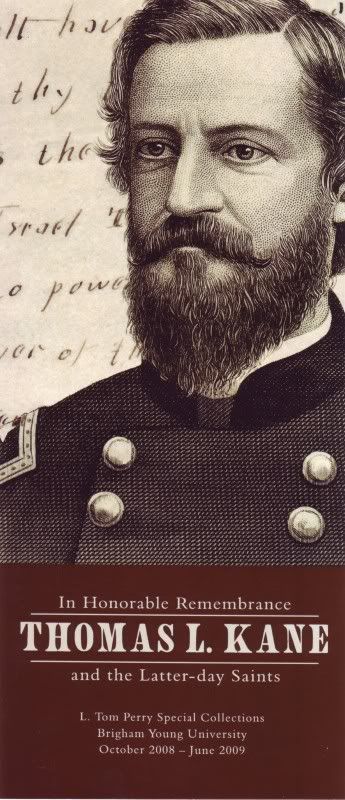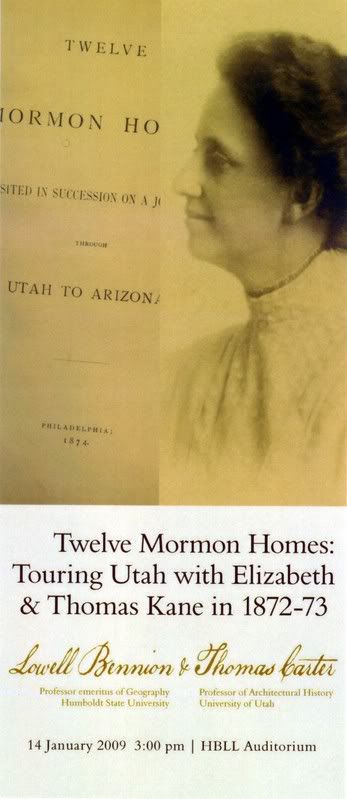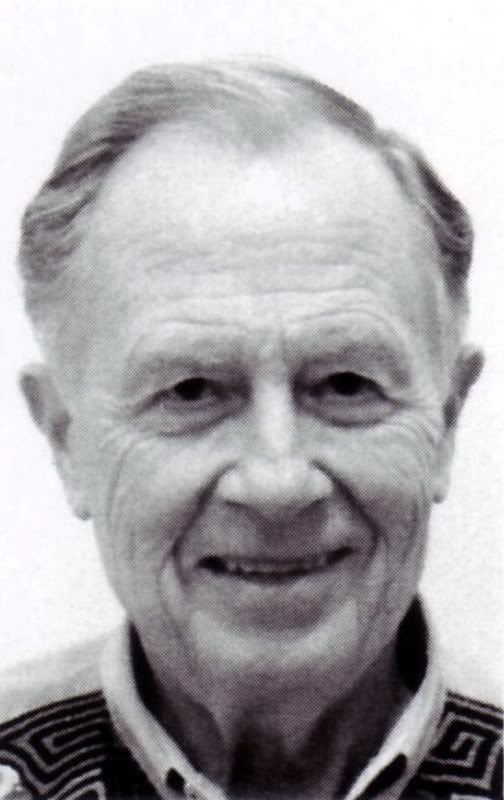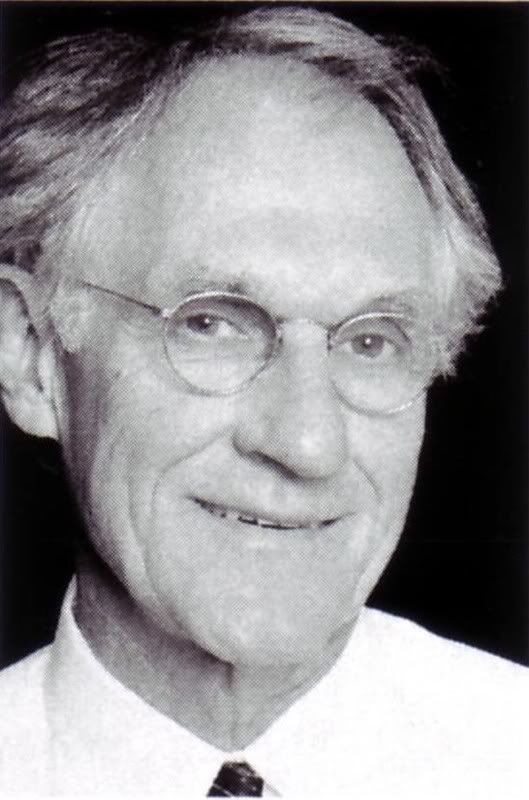 The lecture series sponsored by BYU’s L. Tom Perry Special Collections library, entitled “‘In Honorable Remembrance’: Thomas L. Kane and the Latter-day Saints,” continued yesterday with a dual lecture by Lowell “Ben” Bennion and Thomas R. Carter.
The lecture series sponsored by BYU’s L. Tom Perry Special Collections library, entitled “‘In Honorable Remembrance’: Thomas L. Kane and the Latter-day Saints,” continued yesterday with a dual lecture by Lowell “Ben” Bennion and Thomas R. Carter.
Their lecture, “Twelve Mormon Homes: Touring Utah with Elizabeth & Thomas Kane in 1872-73″, uses as a launch point Elizabeth Kane’s two books about her family’s visit to Utah, which included a wintertime trek to the southern settlement of St. George. The two books, Twelve Mormon Homes Visited in Succession on a Journey through Utah to Arizona and A Gentile Account of Life in Utah’s Dixie are out of print but are standard catalog items for large Utah libraries and are available as used copies at moderate prices from Amazon and no doubt also from your favorite used book dealer specializing in Mormon items.
 The Kane Lecture series is intended to highlight the very large collection of primary Kane materials available at L. Tom Perry Special Collections, with a particular focus on the Kanes’ involvement with the Latter-day Saints. As Curator David J. Whittaker mentioned in his concluding remarks yesterday, the Kane Collection is not only a source of Kane family biographical material, but is so content-rich that it allows scholars to examine issues of Mormon history through outside eyes.
The Kane Lecture series is intended to highlight the very large collection of primary Kane materials available at L. Tom Perry Special Collections, with a particular focus on the Kanes’ involvement with the Latter-day Saints. As Curator David J. Whittaker mentioned in his concluding remarks yesterday, the Kane Collection is not only a source of Kane family biographical material, but is so content-rich that it allows scholars to examine issues of Mormon history through outside eyes.
That is what Ben and Tom did in their lecture: Rather than narrating the Kanes’ experiences on their tour through Mormon Utah, they used the Kanes’ route, the homes they stayed in and the stories of the people they met, to examine plural marriage as it was actually lived. While briefly branching out to other places and families, both focused largely on the town of Nephi, and even more specifically on the family of Samuel Pitchforth, with whom the Kanes stayed overnight.
In alternating talks, heavily illustrated with photographs, tables, maps, census images, and charts, Ben spoke chiefly about the prevalence of polygamy within Mormon society, and Tom about the physical space — the homes — in which those plural lives were lived.
 Ben didn’t bother to refight the tired argument over whether 3% of Mormons practiced polygamy — or 5% — or 20% — or some other figure. He noted that in significant ways, all of Mormon society in Utah was polygamous: While only a small minority of husbands had multiple living wives, that minority was connected by intimate ties to other families who may have been polygamous. That is, while any number of married couples may have been monogamous — may have strongly resisted the idea of plurality within their own marriage, even — they almost certainly had close relatives who were polygamists: a daughter may have been a plural wife, or, if she married monogamously, she may have married the son of polygamists, giving her children polygamous grandparents. A brother may have taken a plural wife, or have married the daughter or sister of polygamists. A widowed mother may have married again, either polygamously herself or into a family with its own intimate polygamous ties. In other words, plural marriage was inextricably woven into the family structure of 19th century Mormon Utah.
Ben didn’t bother to refight the tired argument over whether 3% of Mormons practiced polygamy — or 5% — or 20% — or some other figure. He noted that in significant ways, all of Mormon society in Utah was polygamous: While only a small minority of husbands had multiple living wives, that minority was connected by intimate ties to other families who may have been polygamous. That is, while any number of married couples may have been monogamous — may have strongly resisted the idea of plurality within their own marriage, even — they almost certainly had close relatives who were polygamists: a daughter may have been a plural wife, or, if she married monogamously, she may have married the son of polygamists, giving her children polygamous grandparents. A brother may have taken a plural wife, or have married the daughter or sister of polygamists. A widowed mother may have married again, either polygamously herself or into a family with its own intimate polygamous ties. In other words, plural marriage was inextricably woven into the family structure of 19th century Mormon Utah.
Even if a family somewhere, somehow, had no polygamous members, the very society in which that family lived was polygamous: Church and civil and social leaders, tradesmen and neighbors and schoolmates, were members of polygamous families, to the extent that no Mormon family could have functioned without acknowledging and interacting with plural marriage.
To illustrate the polygamous saturation of society, Ben identified all of the households in Nephi at the time of the Kanes’ visit, then briefly told the stories of individual households: This family was polygamous at the time of the visit; that family became polygamous when the husband was finally able to find a plural wife after 12 years of trying; this other family established polygamous ties when a child married into that family — all easily understood by the audience through the use of Ben’s illustrations, which I unfortunately cannot reproduce here for your benefit. Directly relevant to the Kanes’ visit, the family of Samuel Pitchforth, in whose house the Kanes stayed, included two wives, a first wife with no children, and a second wife with several children; Elizabeth Kane was surprised by the “true intimacy” between the wives.
Other (irreproducible) parts of Ben’s lecture were illustrated by a map suggesting the prevalence of plural households in numerous other towns in Utah that year; a map of Nephi showing the location of polygamous families — there was a heavy concentration in the immediate neighborhood of the Pitchforth home, but the town was fairly well sprinkled with such families in all its neighborhoods; and a table comparing Mormon to general US demographics, with Mormondom far outstripping the wider population in the number of small children (Ben offered some amusing quotations from observers of Mormon baby production).
 Where Ben focused on the people the Kanes were likely to have met, Tom Carter emphasized the architecture of the homes occupied by those people. By use of photographs and pen-and-ink (or, I suppose, more literally computer-generated) drawings, he showed us the facades of the houses visited by the Kanes. With few exceptions, like the one- and two-room log cabins hosting them in Scipio, and the fortified dwelling at Cove Fort, the houses were generally what he called “I-houses” (named that by architects at some point because they were so common in the “I” states of Iowa, Illinois, and Indiana): two story brick homes, with two rooms on each floor, with perhaps a one-story ell added to the back to house a kitchen and other service rooms. The style of these homes is what most of us think of as middle American: think of the standard brick home at Nauvoo (which often had the added stylistic detail of the, um, the term escapes me — the twinned flat decorative things at each end of the roof), or the two-story midwestern frame homes that Sears was always painting white in their old commercials.
Where Ben focused on the people the Kanes were likely to have met, Tom Carter emphasized the architecture of the homes occupied by those people. By use of photographs and pen-and-ink (or, I suppose, more literally computer-generated) drawings, he showed us the facades of the houses visited by the Kanes. With few exceptions, like the one- and two-room log cabins hosting them in Scipio, and the fortified dwelling at Cove Fort, the houses were generally what he called “I-houses” (named that by architects at some point because they were so common in the “I” states of Iowa, Illinois, and Indiana): two story brick homes, with two rooms on each floor, with perhaps a one-story ell added to the back to house a kitchen and other service rooms. The style of these homes is what most of us think of as middle American: think of the standard brick home at Nauvoo (which often had the added stylistic detail of the, um, the term escapes me — the twinned flat decorative things at each end of the roof), or the two-story midwestern frame homes that Sears was always painting white in their old commercials.
Tom corrected one very widespread Mormon/Utah legend, the mistaken impression that two front doors on such an I-house indicated that the home had been built by and for a polygamous family. Absolutely nothing about marital status can be learned by the presence of either one or two doors on the front of these houses, he says — throughout the country, wherever these homes were built, in even the most monogamous of communities (illustrated by a photograph of a two-door house around the corner from where Tom lived in Bloomington, Indiana), esthetics demanded symmetry, both inside and out. You could build an I-house with a single door smack in the middle of the facade, which would certainly be symmetrical, but inside you either had to build a central hallway with interior doors leading to the rooms on each side (which made the interior rooms smaller than they could have been without the hall), or else the front door would lead directly into one of the rooms, making that room larger than the one without the door (destroying interior symmetry). Another popular solution was to put two doors on the front, one leading to each of the identically-sized interior rooms. Voila! symmetry.
There is no discernable pattern to how a house was used by plural families, Tom said. Some families may have given equal space to each wife (hence the urban legend that each had her own front door leading to her own living quarters). In the case of the Pitchforth family, where all the children were children of one wife, and whose house also sheltered Pitchforth’s divorced sister and her children, such an equal division of space would have been illogical and inefficient. Some houses may have provided private living quarters for each family, but others, due to the size of the family, may have required dormitory-style housing of the numerous children. Some families added on to their homes as family size or wealth increased. Houses changed hands over time, perhaps sheltering, alternately, monogamous and polygamous families — and of course the architecture didn’t change when the makeup of the family inside did.
Nothing about domestic architecture, Tom said, clearly indicated “a polygamous family lives here” to the casual traveler. Yet, he said, even without visual clues, of course everyone who lived in the town for any time knew which houses were occupied by plural families, which not. Polygamy was a factor in the landscape in that sense, one of the visible-yet-invisible cues which ordered the world of 19th century Mormons.
All of the lectures in this series will be published as a book in a few months. I look forward to seeing this lecture in print perhaps more than the others, assuming it is fully illustrated, because so much of what both Ben and Tom spoke of was conveyed by the charts and maps and photographs. And this lecture is only a taste of what is coming in the larger project planned by Ben Bennion and Thomas Carter — an examination of all twelve homes referred to by Elizabeth Kane, and the families who lived in them, as well as the additional houses and families known by the Kanes both before and after their Dixie journey. That book should be a major contribution to Mormon Studies, an examination of the Principle lived rather than as it was taught or remembered, drawing heavily on the experiences, pedigrees, and stories of individual families.
The next Kane Lecture is scheduled for February 11, with Edward A. Geary’s talk on “Tom & Bessie Kane & the Mormons.”
Continue reading at the original source →



